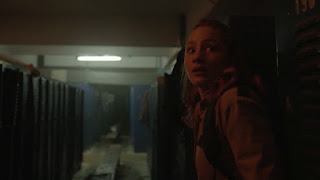Originally published on Set The Tape
New Uruguayan horror Virus: 32 has been marketed as a zombie movie, and whilst it does share some similarities with the zombie genre it’s very much its own animal. Following a mother and daughter with a tough relationship as a deadly virus sweeps through the city, Virus: 32 is a tense and creative survival horror story.
The film begins innocently enough, introducing viewers to the inhabitants of an apartment building where our lead, Iris (Paula Silva), lives with her flatmate. Whilst nothing obviously awful happens we do get a hint that something terrible is stirring just beneath the surface, when one of her elderly neighbours attacks and kills their pet bird. We learn that Iris is separated from her partner, and has temporary custody of her daughter Miriam (Sofía González).
Iris is introduced as a young woman who likes to party, whose apartment is filled with empty bottles and drugs. She doesn’t seem to take her life seriously, and has managed to mess up her plans to take care of her daughter by agreeing to work the night shift at the local community centre where she’s a security guard. She’s pretty far from being the mother that Miriam needs in her life. Despite her flaws, she tries to do her best, and sneaks Miriam into the community centre to spend the night with her. Whilst the two of them are inside the building something begins to spread throughout the city: a virus that drives those infected into a murderous rage. With their exit blocked off, the two of them must try to find a way to survive the night and make it to safety.
Virus: 32 is less of a zombie film, and is more in line with 28 Days Later, and I think people who enjoyed this British horror film (which is now 20 years old!) will find a lot to like with this movie. If you watched 28 Days Later and wanted to know what happened during the initial outbreak, to see the chaos of the virus tearing through society and causing havoc, this film pretty much does that, though on a small scale. Due to the budget of the movie being pretty low we never really leave the confines of the community centre. Anything that’s happening beyond those walls we see in the distance, we hear as faint screams and sirens.
Rather than being a negative, I thought that this actually helped the film in a lot of ways. It made the film have to focus on this very personal story, of this one woman trying her best to be a good mother and to protect her daughter whilst the world goes to hell around her. We know that awful things are happening everywhere else because we can see it in the distance, but we don’t need to focus on that. It doesn’t matter where this virus came from, if the government are doing anything about it, and how many other survivors there are because those things don’t matter to Iris in this moment. The only thing that matters is her and Miriam’s immediate survival, and the film does a great job on pushing that to the fore.
The lead actress, Paula Silva, does brilliantly in the role of Iris. When first introduced there’s no indication that she’s a mother. She acts like a woman barely out of her teens, more focused on the next time she can go out partying than she is on her daughter. Obviously there are parents like this in the world, and not acting in a traditional motherly role doesn’t take away her parenthood, but it’s rare to see a parent depicted this way in film. This is a big part of her story, however, and over the course of the film Iris is forced to step up and be a better mother, facing her own issues and the reason why she’s the way she is in order to do so. Considering how short the runtime of the film is and how much gets focused on the horror of surviving against the infected, we get a surprising amount of time given over to her characterisation and her backstory – something that proved to be one of the more interesting parts of the movie.
The film also tries to do something a little different with the infected, and adds a unique spin on things. Whilst they’re most similar to the rage infected in 28 Days Later, these infected don’t seem to be angry all the time, and when not actively hunting people they will wander around places, performing small tasks. This makes them pretty creepy at times, and we get some very tense moments where Iris has to try and sneak past them as they do their thing. But there’s also another added twist. Whenever the infected perform a violent act, whenever they kill anything, the rush of having killed seems to send them into a trance-like state where they shut down. This allows survivors a few moments, 32 seconds to be precise, to try and get away, sneak past, or kill them, whilst they do nothing. This is something that I’ve never seen in a zombie infection style movie before, and adds a whole new element; though one that I don’t think was utilised nearly enough.
Virus: 32 is an interesting film that’s trying to add some new twists to a pretty well worn formula. Rather than taking a big, grand approach to an end of society story it focuses on the human element, and thanks to some great performances it manages to deliver an engaging, personal story of a mother and daughter and their strained relationship. Fans of zombie infection movies will find a lot of familiar stuff here, but will also discover some new twists on the formula that are pretty unique.



No comments:
Post a Comment